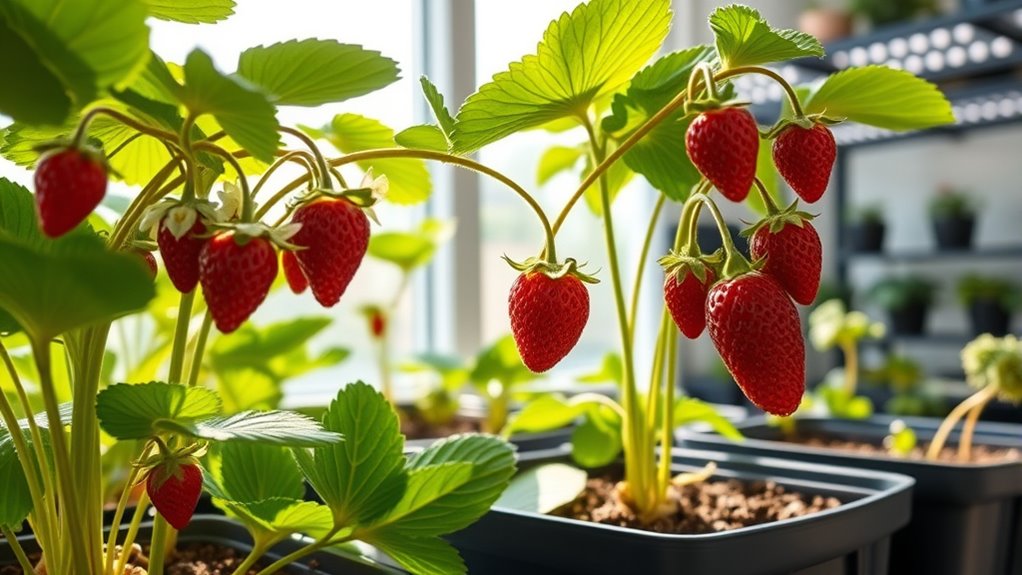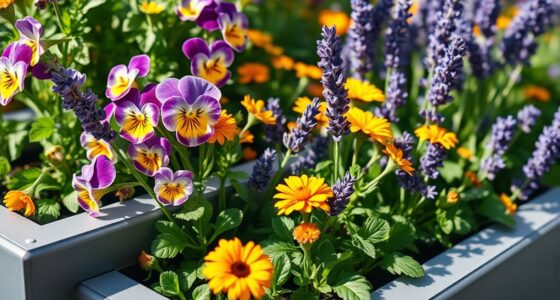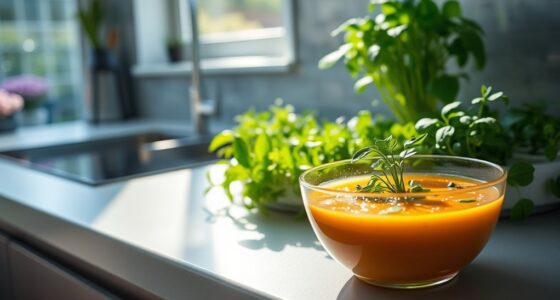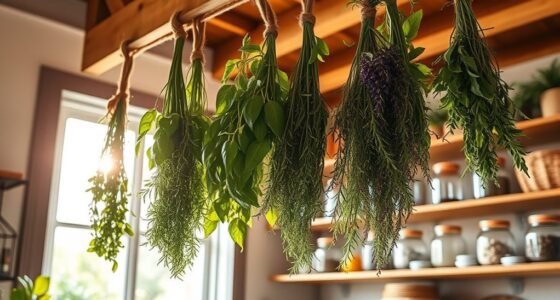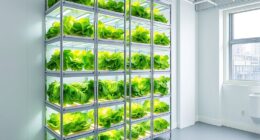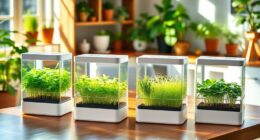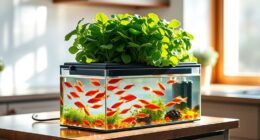To grow sweet strawberries indoors, choose compact, day-neutral varieties suited for small spaces, and plant them in well-draining containers with quality soil. Provide ample light with full-spectrum LED grow lights, ideally 12-16 hours daily, and guarantee proper watering and humidity levels. Regularly fertilize, monitor for pests, and hand-pollinate flowers to boost fruit set. With consistent care and attention, you’ll enjoy fresh strawberries year-round—learn more about perfecting your indoor strawberry garden below.
Key Takeaways
- Select compact, day-neutral strawberry varieties suited for indoor growth and container cultivation.
- Provide full-spectrum LED lighting 12-16 hours daily to support flowering and fruit development.
- Maintain consistent watering and humidity between 60-70% to promote plant health and fruit sweetness.
- Hand-pollinate flowers using a brush or cotton swab to ensure optimal fruit set indoors.
- Monitor for pests and diseases regularly, and create an environment that attracts beneficial pollinators.
Choosing the Right Strawberry Varieties for Indoor Growth

When selecting strawberry varieties for indoor growing, it’s important to choose types that are well-suited to container life and limited space. Focus on variety selection by opting for indoor cultivars specifically bred for small environments. These cultivars typically have compact growth habits, smaller root systems, and are more manageable in pots or containers. Look for strawberry varieties labeled as “day-neutral” or “ever-bearing,” as they produce fruit continuously and are easier to care for indoors. Avoid large, sprawling varieties that require extensive space and support. Indoor cultivars are designed to thrive with less sunlight and can adapt well to indoor conditions. Picking the right varieties ensures you’ll enjoy a bountiful harvest without overwhelming your limited growing space. Additionally, selecting appropriate growing conditions can significantly improve your success with indoor strawberries.
Selecting the Perfect Containers and Growing Medium
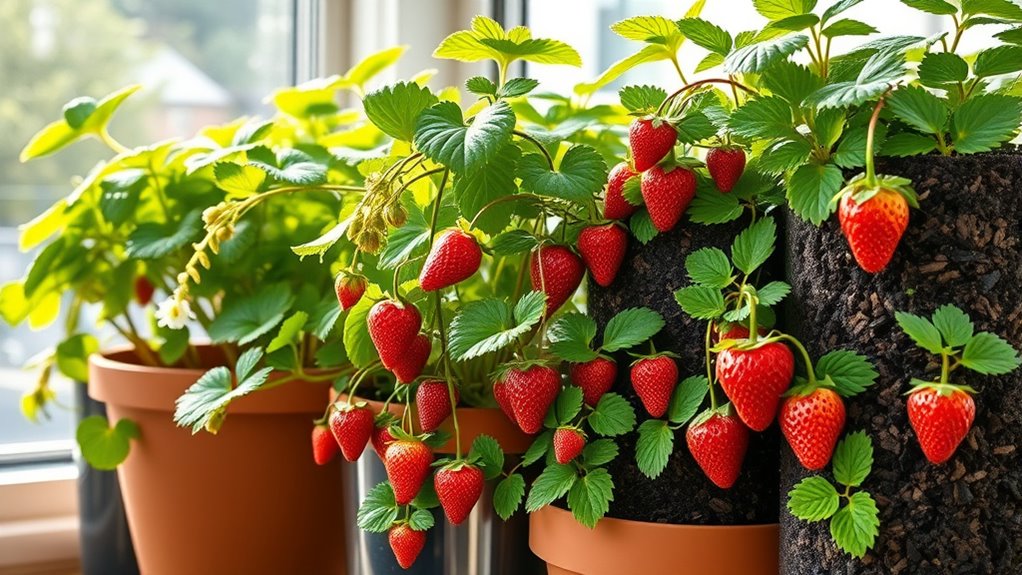
Choosing the right containers and growing medium is essential for successful indoor strawberry cultivation. First, select containers with good container drainage to prevent waterlogging and root rot. A well-draining pot ensures excess water escapes easily. Second, consider the growing medium composition; a mix of peat moss, perlite, and compost provides excellent aeration and nutrients. Third, ensure the container size suits your strawberry variety—larger containers support more vigorous growth. Fourth, avoid containers made of materials that retain too much heat, which can stress plants. Proper drainage and a balanced medium promote healthy roots and lush foliage. Remember, a well-chosen container combined with the right growing medium creates the foundation for sweet, thriving strawberries indoors.
Providing Adequate Lighting for Healthy Development
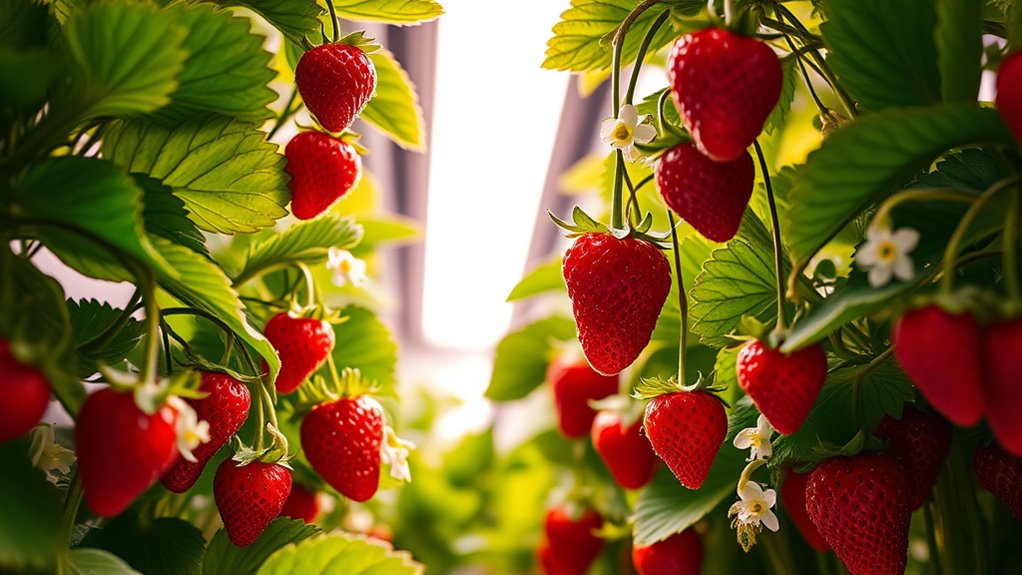
Adequate lighting is essential for indoor strawberries to develop strong leaves, produce fruit, and maintain overall health. While natural sunlight is ideal, it often isn’t enough indoors, especially during winter months. To supplement, use LED grow lights that provide full-spectrum light, mimicking natural sunlight and promoting healthy growth. Position your grow lights about 12-18 inches above your plants and keep them on for 12-16 hours daily to ensure they receive enough light. Consistent lighting encourages robust foliage and sweet fruit development. Avoid neglecting light needs, as insufficient illumination can lead to weak plants and poor yields. Combining natural sunlight with LED grow lights maximizes growth potential, giving your strawberries the best environment for a successful indoor harvest. Proper lighting is crucial for achieving optimal fruit sweetness and plant vigor.
Managing Watering and Humidity for Optimal Growth

Proper watering and humidity control are key to keeping your indoor strawberries healthy and productive. Maintaining consistent soil moisture prevents overwatering or drought stress, which can harm plant growth. To manage this effectively:
- Check soil moisture daily, ensuring it stays evenly moist but not waterlogged.
- Use a moisture meter or finger test to gauge soil conditions accurately.
- Humidity control is vital; keep humidity levels between 60-70% to prevent dehydration or mold.
- Increase humidity by placing a tray of water near your plants or using a humidifier, especially in dry environments.
- Regularly monitoring environmental conditions helps prevent vulnerabilities to cybersecurity threats that could disrupt your gardening tools or systems.
Fertilizing and Nutrient Needs for Indoor Strawberries
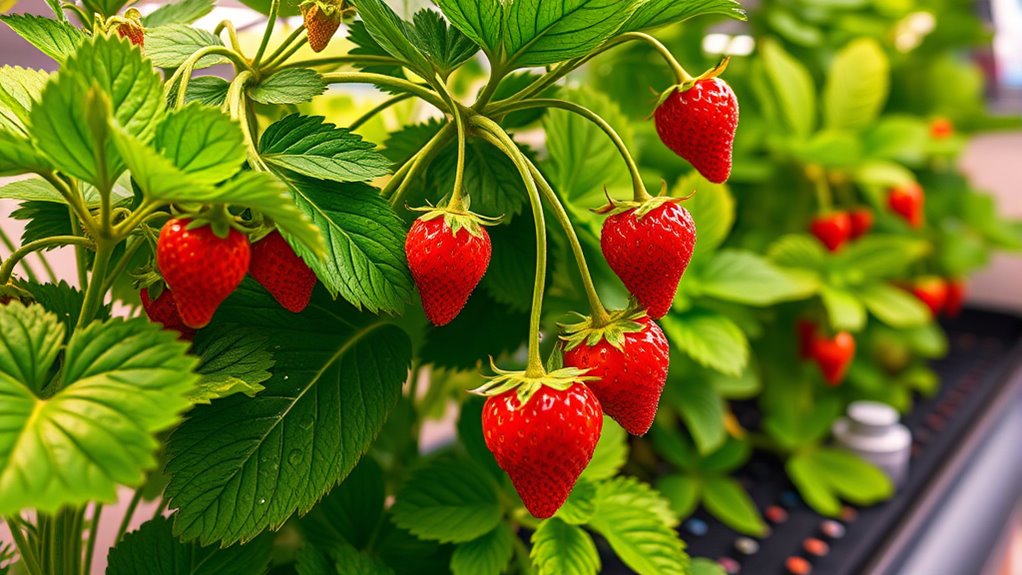
To keep your indoor strawberries healthy, choosing the right fertilizer is essential. You’ll also want to time your nutrients properly to support steady growth and fruit production. Pay attention to signs of deficiencies so you can adjust your fertilizing approach when needed.
Optimal Fertilizer Types
Ever wondered which fertilizers best support your indoor strawberry plants? Choosing the right fertilizer types is vital for healthy growth and sweet fruit. For indoor strawberries, opt for balanced nutrient solutions that provide essential elements. Here are four tips:
- Use liquid or water-soluble fertilizers for quick absorption.
- Select formulas with equal or slightly higher phosphorus for fruit development.
- Incorporate organic options like compost teas or fish emulsion for a gentle nutrient boost.
- Avoid over-fertilizing; follow label instructions to prevent nutrient burn.
- Consider vetting fertilizer products to ensure they are safe and effective for edible plants.
These nutrient solutions help maintain ideal soil conditions, promoting lush foliage and abundant berries. Remember, the right fertilizer types ensure your strawberries stay healthy and produce sweet, juicy fruit indoors.
Nutrient Timing Strategies
Timing your fertilizer applications is key to guaranteeing your indoor strawberries receive nutrients when they need them most. Proper nutrient scheduling and fertilizer timing promote healthy growth and sweet fruit. Typically, you should fertilize every 2-3 weeks during active growth, adjusting based on plant response. Use a balanced, water-soluble fertilizer for consistent nutrient delivery. To help you plan, consider this schedule:
| Growth Stage | Fertilizer Timing |
|---|---|
| Vegetative Stage | Weekly or biweekly applications |
| Flowering & Fruiting | Every 1-2 weeks |
| Dormant Period | Reduce or skip fertilizing |
Stick to this schedule, monitor plant health, and adjust as needed. Consistent nutrient timing ensures your indoor strawberries thrive and produce sweet, juicy berries.
Signs of Deficiency
Are your indoor strawberries showing unusual symptoms? Leaf discoloration is often a key sign of nutrient deficiencies. To identify issues early, look for:
- Yellowing leaves, which indicate nitrogen deficiency.
- Purple or reddish stems, suggesting phosphorus deficiency.
- Pale or streaked leaves, pointing to iron deficiency.
- Browning leaf edges, often caused by potassium deficiency.
These signs signal your plants aren’t getting essential nutrients. If ignored, they can stunt growth or reduce fruit production. Regularly check your strawberry plants for these symptoms and adjust your fertilizing routine accordingly. Proper fertilization helps prevent nutrient deficiencies, ensuring your strawberries stay healthy and produce sweet, vibrant fruit. Additionally, understanding the role of contrast ratio in your grow lights can optimize light conditions for better plant health. Remember, timely intervention is vital to keep your indoor strawberries thriving.
Pollination Techniques to Boost Fruit Production

To maximize your indoor strawberry harvest, effective pollination is vital. You can use hand pollination techniques or create conditions that attract pollinators indoors, like placing a small fan or using plants that draw insects. Timing your pollination efforts correctly ensures you get the best fruit set and quality. Additionally, understanding the foraging range of pollinators can help you optimize your setup for better pollination efficiency indoors.
Hand Pollination Methods
When natural pollinators are scarce indoors, hand pollination becomes an effective way to guarantee your strawberries produce fruit. DIY pollination is simple and requires minimal tools. Use hand pollination tools such as a small brush, cotton swab, or toothbrush to transfer pollen from the anthers to the stigma. To maximize success, follow these steps:
- Gently shake or tap the flower to dislodge pollen.
- Collect pollen with your chosen tool.
- Carefully brush pollen onto the stigma of the same or neighboring flowers.
- Repeat daily during flowering to ensure good pollination.
This method boosts fruit production, especially when natural pollinators can’t reach your indoor plants. Consistency and patience will help you enjoy sweet, home-grown strawberries year-round.
Attracting Pollinators Indoors
Since natural pollinators are often absent indoors, creating an environment that attracts beneficial insects can considerably boost your strawberry plants’ pollination. To attract pollinators indoors, consider adding potted flowering plants like marigolds or lavender nearby. These plants release scents that draw in bees and other helpful insects, enhancing bee activity indoors. You can also install small insect hotels or bee houses to provide shelter, encouraging beneficial insects to settle nearby. Proper lighting and maintaining a warm, humid environment can further promote pollinator activity. Keep your space free of pesticides, which can deter or harm these insects. Additionally, understanding the importance of attention in creating a conducive environment can help you optimize your pollination efforts. By actively attracting pollinators indoors, you’ll improve pollination efficiency and increase your strawberry plants’ fruit yield, ensuring a sweeter, more productive harvest.
Optimal Pollination Timing
Timing is essential for maximizing strawberry pollination indoors, as plants are most receptive during specific periods. Knowing your pollination window helps you achieve better fruit set and sweetness. To guarantee ideal timing precision, monitor your plants closely and act at the right moment. Here are key tips:
- Observe flower blooms daily for signs of readiness.
- Pollinate when petals are fully open, usually in the morning.
- Use a gentle brush or cotton swab to transfer pollen if natural pollination is limited.
- Repeat pollination every 2-3 days during peak flowering.
- Ensure good lighting conditions, such as ambient, task, and accent lighting, to encourage healthy flowering and optimal pollination.
Troubleshooting Common Problems and Pests
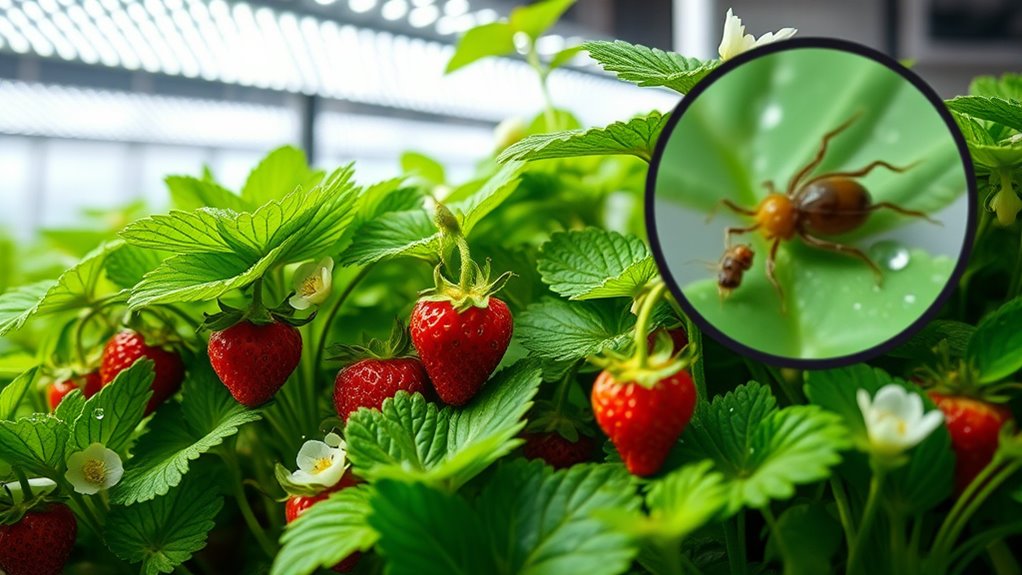
Growing strawberries indoors can be highly rewarding, but it’s common to encounter problems like pests and diseases that can hinder your plants’ growth. Early pest identification is key to preventing damage, while disease prevention helps maintain healthy plants. Regularly inspect your strawberries for signs of trouble, such as discolored leaves or holes. Use the table below to recognize common issues:
| Problem | Solution |
|---|---|
| Aphids or spider mites | Spray with insecticidal soap |
| Fungal diseases | Improve airflow and avoid overwatering |
| Root rot | Ensure well-draining soil |
| Powdery mildew | Remove affected leaves and improve ventilation |
Being aware of plant pests and their signs can help you take quick action to protect your strawberries.
Frequently Asked Questions
How Can I Prevent Mold and Mildew Indoors?
To prevent mold and mildew indoors, you need to control humidity levels and guarantee proper ventilation. Use a dehumidifier or air conditioner to keep humidity below 60%, and open windows or use fans to circulate air. Regularly check your plants for signs of excess moisture or mold, and remove any affected leaves promptly. Good airflow and humidity control create an environment that discourages mold and mildew growth, keeping your strawberries healthy.
What Are the Best Methods for Pest Control Indoors?
An ounce of prevention is worth a pound of cure. You can keep pests at bay by choosing pest-resistant strawberry varieties and practicing companion planting. Regularly inspect your plants for signs of pests, and remove any affected leaves promptly. Encourage beneficial insects like ladybugs and use natural sprays when needed. These methods help create a healthy, pest-free environment, ensuring your indoor strawberries thrive and stay delicious.
How Do I Extend the Strawberry Harvest Season Indoors?
To extend your strawberry harvest indoors, focus on ensuring consistent pollination and proper container choices. You can manually pollinate your plants with a small brush or by gently shaking the flowers, especially if natural pollinators are absent. Use strawberry container options that provide good drainage and space for root growth. Keep the environment warm and well-lit, and regularly harvest ripe berries to encourage continued fruit production.
Can I Grow Strawberries Year-Round Indoors?
Yes, you can grow strawberries year-round indoors with proper care. Make sure your indoor lighting provides enough brightness, ideally using grow lights to mimic sunlight. You’ll also need to actively pollinate your plants, either by gently shaking the flowers or using a small brush to transfer pollen. With consistent temperature, adequate light, and pollination, you can enjoy fresh strawberries throughout the year, regardless of the season.
What Are Signs of Nutrient Deficiencies in Indoor Strawberries?
You might notice nutrient deficiency symptoms like yellowing leaves, stunted growth, or poor fruit development in your indoor strawberries. If these signs appear, consider soil testing to check nutrient levels. Lack of essential nutrients like nitrogen, potassium, or magnesium can cause these issues. Address deficiencies by adjusting your fertilization routine with balanced, water-soluble fertilizers, and guarantee your soil or growing medium provides adequate nutrients for healthy strawberry plants.
Conclusion
So, armed with these tips, you’re now a clandestine strawberry farm in your living room—posing as a sophisticated gardener while secretly plotting to outshine grocery store berries. Remember, patience and a little bit of science will turn your indoor oasis into a sweet success story. Who knew that growing strawberries could be your latest, most charming act of domestic rebellion? Now, go on and make those berries blush with envy!
